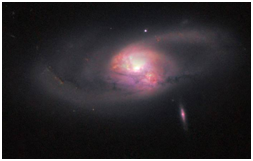Last month, staff at BioMed Central took a day off from publishing science, to get involved in doing some! One of several citizen science projects engaged in was Galaxy Zoo. Grant Miller and Robert Simpson from Galaxy Zoo tell us more about the project.
As part of his PhD in astrophysics, Kevin Schawinski was asked to look through a catalogue of almost a million galaxies to sort the spiral-shaped objects from the elliptical ones. This simple two-way split in appearances is fundamental to a galaxy’s evolution, history and astrophysical properties. It’s trivial to tell them apart but no automatic method could reliably perform the same task.
Kevin spent a week working on the problem and managed to go through 50,000 galaxies. Quite a feat, but only a fractional step toward the million in total. He teamed up with a colleague Chris Lintott, from the University of Oxford, UK. Inspired by Stardust@Home the pair decided to ask the public to help and launched a website called Galaxy Zoo in July 2007. The premise was simple: look at one of the galaxies and click one of six buttons to denote it’s shape.
Galaxy Zoo was a runaway hit and 165,000 volunteers classified every one of the million galaxies about 40 times a piece. The resulting catalogue has been used in hundreds of research papers and the website has continued and evolved.
The power of crowd-sourcing
Galaxy Zoo is one form of ‘citizen science‘. It is also a crowdsourcing project. Not only did this allow Galaxy Zoo to complete this daunting task faster than Kevin, it produced a far superior catalogue. Kevin (now a professor at ETH in Zürich, Switzerland) would undoubtedly for example, have gotten some galaxies wrong. Galaxy Zoo however can take 40 votes on each galaxy image and find a statistical measure of the answer. Simple statistics is the power of crowdsourcing in this case. Malevolent classifiers as easily dispensed with as noise in the classification data, and the good intentions of the vast majority win through and make Galaxy Zoo an unparalleled success.
The curious incident of the ‘voorwerp’ in the universe

Perhaps more interestingly were the results the science team did not expect Galaxy Zoo to produce. After signing up to try Galaxy Zoo, Hanny van Arkel (a Dutch schoolteacher) saw a strange fuzzy blue blob next to one of the galaxies (see image left) she was asked to classify. She posted the image on the Galaxy Zoo discussion forum and her simple question “what’s this?” ignited a chain of other questions from the science team that they could not answer. The Galaxy Zoo team eventually observed it with the Hubble Space Telescope and discovered it to be a unique object in the universe: a quasar light echo revealing the nature of a nearby black hole.
Hanny’s ‘Voorwerp’ – Dutch for ‘object’ – had been visible in other astronomical surveys but nobody until Hanny had asked what it was. A human’s innate curiosity cannot be replicated by computer code (at least not yet) and such curiosity is required to find odd and interesting voorwerps in data. This kind of serendipitous discovery has been seen several times in Zooniverse projects and are one of the most powerful reasons to let the classifying volunteers see the images and freely explore and discuss them.
Zooniverse: the growing family of Galaxy Zoo
Galaxy Zoo spawned a larger collection of projects created by a team in Oxford and now in Chicago too: the Zooniverse. The Zooniverse currently consists of 18 citizen projects, all asking users to help classify large datasets that computers cannot handle. At planethuners.org you can search for exoplanets in data from NASA’s Kepler spacecraft; at cellslider.net the public are sorting cancer cells for Cancer Research UK; at wormwatchlab.org people have to watch nematode worms lay eggs for genetic research; and at snapshotserengeti.org volunteers describe amazing animals in photographs taken by automated cameras in Tanzania.
The Zooniverse is not the only player in online citizen science. Projects such as Fold.it, EyeWire and eBird all have their own approach to the task of crowdsourcing research in protein folding, neuroscience and ornithology respectively. There are likewise many websites and directories for those wishing to take part in citizen science on the web. These are not all just online projects, with many projects asking people to get their hands dirty and actually go out and collect data.
The Zooniverse is currently focussed on building new projects in new areas of research – with recently launched sites including Plankton Portal and Cyclone Center. There is also a redoubled effort to assist volunteers to explore the data on their own. To that end Zoo Tools has been developed, a set of easy-to-use web tools for handling data from Zooniverse projects and sharing that analysis with others.
The Zooniverse’s parent organisation the Citizen Science Alliance runs an open call for projects which you can find here.
Comments